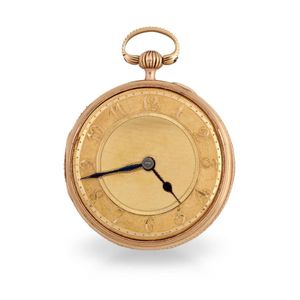18ct Gold Pocket Watch by Osborne & Molineaux, Dublin (1820)
You must be a subscriber, and be logged in to view price and dealer details.
Subscribe Now to view actual auction price for this item
When you subscribe, you have the option of setting the currency in which to display prices to $Au, $US, $NZ or Stg.
- Fusee - The fusee movement was used in clocks and pocket watches from the mid 17th century. The fusee is a cone shaped drum within the works that is linked to the barrel of the spring, usually by a length of chain.
As the mainspring loses its tension over time, the cone shaped barrel compensates for this by increasing the tension, by pulling the mainspring tighter, thus ensuring the time remains constant.
Use of the fusee in clocks was superseded by the "going barrel" in the mid 19th century and for pocket watches at the beginning of the 19th century.
The fusee continued to be used in marine chronometers until the 1970s. - Foliate - Decorated with leaves or leaf-like forms.
- Movement - The technical name for the workings of a clock or watch, and does not include the dial or case.
- Circa - A Latin term meaning 'about', often used in the antique trade to give an approximate date for the piece, usually considered to be five years on either side of the circa year. Thus, circa 1900 means the piece was made about 1900, probably between 1895 and 1905. The expression is sometimes abbreviated to c.1900.
- Engine Turned - Engine turning is a decorative technique used on metal surfaces to create intricate curving or geometric pattern. The process involves cutting a series of lines into the surface of the metal using a rose engine or decoration lathe which rotates the metal as it cuts, allowing the operator to create a repeating pattern that covers the entire surface. The resulting surface has a shimmering, reflective quality that is often described as "engine turned." Where an engine turned item has been enamelled, the term used to describe the decoration is usually guilloche.
Engine turning was originally developed to decorate metal objects such as firearms, scientific instruments, and other metal objects that required precise and elegant design.
This item has been included into following indexes:
Visually similar items

David Morice An 18ct gold open-faced pocketwatch mvt 4429 English circa 1840, english fusee cylinder movement signed and numbered David Morice, Fenchurch Street no. 4429, cylindrical pillars, diamond endstone, gold engine-turned dial, Arabic numerals, blue

A Swiss 19th century ladies open face fob watch, c.1890, the floral engraved stamped case in 18ct gold with gold dial. Lever 3/4 plate movement, (some dents in the back cover). Diameter 40 mm.

An early Victorian gold consular case open face pocket watch, ornate engraved and chased dial in three colour gold. Halmarked Chester 1844. Fusee and chain lever movement by Thomas Russell & Sons. Diameter 42 mm. TW 53.7gms.

A ladies Swiss gold pendant watch, c.1890, engraved 14ct gold case with gold face and 3/4 plate, English lever movement by Thomas Russell & Sons. Diameter 38 mm.
